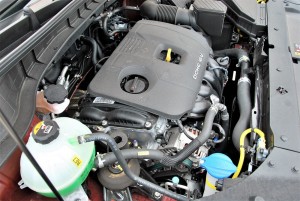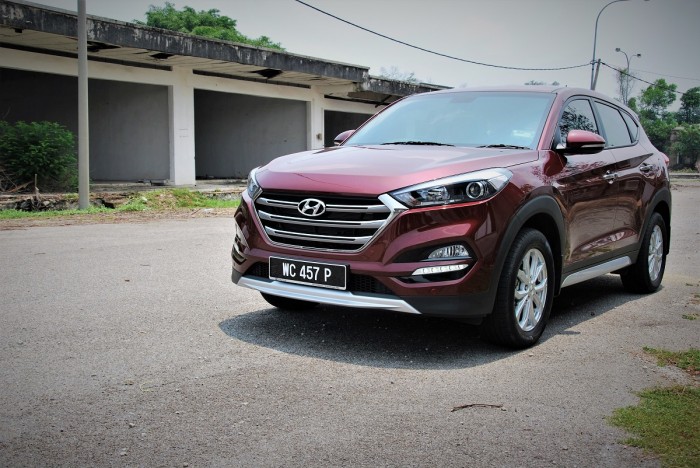Test Drive Review : Hyundai Tucson
What’s This?
Hyundai Motor Company’s product portfolio has come a long way. While the 1st generation Hyundai Tucson wasn’t bad looking, it didn’t make any hearts go a-flutter nor any heads turn. The 2nd generation changed the game for the company, with its (then) new Fluidic Sculpture design theme that made a box sleek. The unit reviewed is the 3rd generation of the popular compact crossover from the Korean automaker, still dressed in Fluidic Sculpture but in the squarer v2.0 guise. The new look gives the Hyundai Tucson a more masculine demeanor; it’s also slightly larger (longer by 65 mm and wider by 30 mm thanks to a 30 mm longer wheelbase) than its curvy predecessor.
What About It?
Now that Hyundai has had time to streamline all its product offerings to ensure adherence to the design theme, the new Tucson looks very similar to the larger Santa Fe SUV. Unless you’re an avid car-fan, that similarity is likely to cause some confusion. But it’s not all bad as the Santa Fe too is a handsome vehicle. On that note, it must be clarified that the new Tucson won the 2016 iF Design Award.
Design-wise, Fluidic Sculpture 2.0 is a more mature interpretation of curves, giving the Tucson more masculine lines and an edgier look. The body profile is well-proportioned. The signature hexagonal grille of the reviewed Executive variant (top-of-the-range) gets chromed and takes centerstage with sleek halogen projector headlights, fog lights and LED daytime running lights bordering it.
What’s Inside?
The review unit was fitted with red leather seats (a RM 1,288 option) which looked ‘loud’ initially, but as time progressed, I began to appreciate its presence as it matched well with the Ruby Wine exterior. Now, I seldom expect much from seats of vehicles in this price range but the quilt-patterned seats not only felt comfortable, it also looked upmarket. The back of the front seats are encased in plastic so scuff marks from excited young shoes shouldn’t be a problem. There is also an option for white Nappa leather which looks good and make you well-loved by your car detailer.
 The rear seats can accomodate 3 passengers but it’s more comfortable for 2 due to the seat hinges as well as the armrest in the seat-back, which is tolerable but not ideal on long trips. On the bright side, the rear seat-back reclines and also splits 60:40 for flexible storage. Rear cargo space is 488 liters with the seats up, which isn’t capacious by today’s standards (there’s a budget A-segment sedan which tops this by a good 20 liters), but is by and large practical for most uses; the folding rear seats also increase storage capacity and flexibility. A retractable tonneau cover hides your content and when more cargo space is needed, it can be taken off and stored in the niche near the tailgate for easy reach. In the cargo area are also a hook and a 12V outlet.
The rear seats can accomodate 3 passengers but it’s more comfortable for 2 due to the seat hinges as well as the armrest in the seat-back, which is tolerable but not ideal on long trips. On the bright side, the rear seat-back reclines and also splits 60:40 for flexible storage. Rear cargo space is 488 liters with the seats up, which isn’t capacious by today’s standards (there’s a budget A-segment sedan which tops this by a good 20 liters), but is by and large practical for most uses; the folding rear seats also increase storage capacity and flexibility. A retractable tonneau cover hides your content and when more cargo space is needed, it can be taken off and stored in the niche near the tailgate for easy reach. In the cargo area are also a hook and a 12V outlet.
The cabin layout is practical with switches and buttons within easy reach. I liked that the air-con vents have been moved slightly up, from the 2nd generation’s, so cold knuckles are no more. The buttons for Drive Modes, Auto Hold and Downhill Brake Control are located near the electric parking brake aft of the gearshift and they’re tactile enough to be used without taking your eyes off the road. The rear view mirror has a built-in electronic compass in case you’re curious what direction you’re driving in and the Tucson is equipped with a video recorder which seems a necessity nowadays.
The supervision cluster with a 4.2″ LCD display shows all your drive information. The infotainment touchscreen unit is powered by Android so anyone familiar with Android smart devices will not feel lost. You can load all your essential apps to the car e.g. Google Maps, Waze, Spotify and even your email (which you shouldn’t be checking when driving).
What’s Underneath?
The new Hyundai Tucson is powered by the 2-liter Nu engine inherited from its predecessor. It produces 155 PS and 192 Nm of torque. Paired to Hyundai’s 6-speed automatic transmission, it takes 10.6 seconds to go  from 0 to 100 km/h; fast enough for normal driving.
from 0 to 100 km/h; fast enough for normal driving.
Gearshifts are smooth as long as you’re not a demanding or enthusiastic driver. Switching the drive to Eco mode could ellicit some complaints but you’ll express gratitude at the end of the month. The Tucson’s on-board trip computer recorded a consumption of 8 liters per 100 km on a long distance trip via highway; in the city, that went up to an average of 10.2 liters per 100 km, which isn’t too bad for a SUV. This was achieved mostly in Eco mode.
Want the best deal on your new car? Click here and fill the form.
What’s It Like?
The Tucson might look like it means business but there’s not a lot of drama to it. I can’t call it lethargic or slow but I can’t call it fast either; it’s just what it is. And it does a great job for what it is, which is to ferry its occupants to the desired destination(s) in a competent and comfortable manner.
Hyundai-Sime Darby has opted for the ‘soft-roader’ 2-wheel drive configuration, which is practical as the majority of buyers will use the Tucson on the tarmac doing the office commute, or school and mall runs. And even if it came with all-wheel drive, the most extreme use of it could be on a grassy curb or a dirt trail to the beach.
The overall feel of the Tucson was comfort and this is helped by good insulation; there’s little noise intrusion into the cabin even at speeds above the speed limit. The suspension soaks up road imperfections well enough but there is some body lean when you’re optimistic about a corner. That’s to be expected for most tall vehicles.
If you do misbehave when driving the Tucson, there’s the Vehicle Stability Management system with Electronic Stability Control, ABS, Brake Assist and 6 airbags to help reduce your idiocy.
Any Interesting Features?
As mentioned earlier, the Hyundai Tucson comes with Downhill Brake Control which takes control of the throttle to help you descend steep slopes safely; a nice feature if you live on a hill. There’s also Drive Mode, which allows you to switch between Normal, Sport and Eco modes, depending on your fancy.
Other features for the Executive variant includes Hill-Start Assist Control, auto headlamps, rear air vents, cruise control, powered driver’s seat, LED daytime running lights, puddle lamps, keyless entry, push button start and reverse camera. However, there is no climate control but the manual knobs are easy enough to use.
On the safety side, the Tucson is the only small SUV in its category to receive a ‘Good’ rating in the US Insurance Institute for Highway Safety (IIHS) small overlap crash test for both driver and passenger.
Who Is It For?
The locally-assembled Tucson is a practical vehicle that’s a smooth and easy drive. It may not be particularly inspiring to drive but it represents good value. There is enough sophistication and premium feel in its appearance and equipment to attract many; its looks also should hold up well as it ages. And this is what anyone with a sensible head for value and kit will look for, and in this regard, the Tucson is built right.
How Much?
The Hyundai Tucson Executive is priced at RM 142,632.60 (on the road without insurance), with a 5-year or 300,000 km warranty. Hyundai-Sime Darby is currently offering 3 years’ or 50,000 km free service for the Tucson.
Gallery:











































































